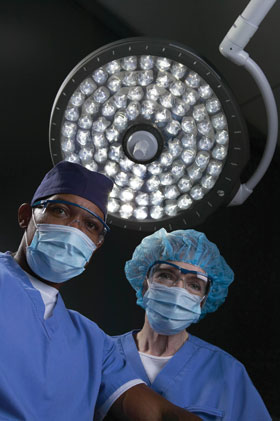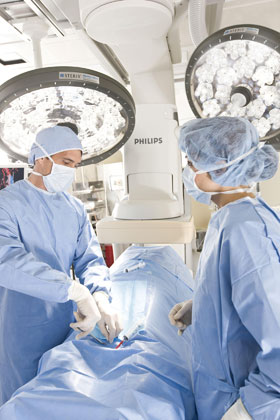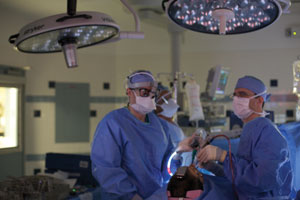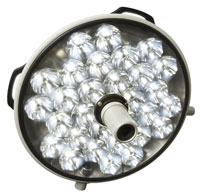“Adding features such as color adjustability poses challenges but can improve the safety of surgeries.” Corey Bergad, Luminus Devices.
LEDs are lighting up the surgical suite. When we looked at the state of the art in surgical lighting systems just three years ago, LEDs were only beginning to enter the conversation. Their rapid adoption is attributed to technological advancements in LED arrays, higher brightness, better color rendering, lower prices and a broader understanding of the lower maintenance and energy costs.

Surgical lighting is designed to prevent shadows resulting from the movements of surgical staff. Photo courtesy of STERIS.
Single color
Just a few years ago, LED-based surgical lighting systems used multicolor arrays made up of red, green, blue and some white LEDs, mixed together to get a bright white. At the time, this was the best way to get high light output, and it was superior to using just white LEDs. One drawback that was noticed by surgeons, however, was that the light would change color when they put a hand into the surgical field, blocking one or more of the colors. Chris Walters, senior product manager at STERIS Corp. of Mentor, Ohio, noted that when colors are blocked, it causes a “color fringing around shadows, which was objectionable to surgeons.” With advancements in coating and LED technologies, pure-white LEDs now emit high-quality light and have all but replaced halogen as the preferred light source in surgical lighting systems.

In a cardiovascular operating room, LED lights are integrated into a surgical lighting system. Photo courtesy of STERIS.
Finding a balance
When choosing surgical lighting, it’s vital to find a system that balances color temperature with color rendering index (CRI) with light brightness. Color temperature, measured in degrees kelvin (K), is generally between 4000 to 4500 K or even more. The higher the color temperature, the closer it is to midday sunlight. But different temperatures are better for seeing specific color tones. A 3500 K light, for example, shows more red or yellow tones. The higher the temperature, the colder the light, so for longer surgeries, a 5000 K light might be preferred to reduce eye fatigue.

LED-based surgical lighting is used in the operating room at Thomas Jefferson University Hospital in Philadelphia. Photo courtesy of Stryker.
CRI refers to how closely a light shows the true color of what it’s illuminating; it should be between 85 and 100. Again, different types of surgeries and individual surgeon preferences come into play. And then to complicate things further, there’s also the R9 value, which indicates how well the light shows deep, saturated shades of red. In surgery, obviously, the color red is critical. An R9 value of 96 is significantly better than most halogen-based systems’ ability to see true reds. This value is offered, for example, by STERIS’ Harmony LED Surgical Lighting and Visualization System.
Brightness (lx) is another consideration. How much is needed depends upon the surgical application, general overhead illumination, surgeon preference, other competing light sources and more. Today’s top-tier LED-based surgical lighting systems can provide 160,000 lx. By comparison, traditional halogen lighting typically provides only 120,000 to 136,000 lx.
The Visum LED Surgical Light from Stryker Communications of Dallas is an example of a light that delivers 160,000 lx and also uses proprietary reflector technology that eliminates shadows. Chad Croasdale, vice president of marketing, explained that some companies use a design with a single LED in each reflector, which tends to shine straight down. Adding to that, Jon Arndt, marketing manager at Stryker, noted that shining straight down causes the “flashlight effect,” where each LED shows up as a single spot. Instead, Stryker uses multiple LEDs in each reflector, creating what Arndt calls a more homogeneous light field. To avoid the complexity of having to specify each level of color, light intensity, etc., today’s surgical systems are highly tunable. Stryker’s system, for example, has eight brightness settings up to the maximum of 160,000 lx.

A close-up of an LED-based surgical light with a camera shows a unique reflector technology. Photo courtesy of Stryker.
In addition to brightness and efficiency, a benefit of LED technology is the ability to eliminate ultraviolet and infrared light waves. Infrared wavelengths are what the surgical team experiences as heat from the lights, and ultraviolet wavelengths contribute to wound drying during extended exposure. While LEDs, by nature, eliminate some of the heat, the other factor in creating a “cool” surgical light is in its construction. According to Arndt, Stryker’s choice to use aluminum for the light was based on two factors: durability and heat dissipation. “These lights can be on at 100 percent intensity all day, and they are still cool to the touch.”
According to Corey Bergad, product manager at Luminus Devices, which makes the Phlatlight LED used in fiber-based endoscopic applications, tunability is necessary in today’s surgical applications, but it does add to the complexity of the design. “Adding features such as color adjustability poses challenges but can improve the safety of surgeries.” In today’s surgical suite, there are many types of backlit equipment competing for attention. High-density video monitors hang from the ceiling, cameras or microscopes slide in on tracks, and more. All of these add complexity to visibility as well as ease of use, when the end goal remains the same: positive patient outcomes, which is where tunability becomes paramount.
Reducing shadows
Surgical lighting designers take different approaches to reducing shadows, the nemesis of any surgeon. The STERIS system, for example, uses 84 lenses to deliver light from multiple angles, which reduces shadows. Walters noted that one challenge in using so many overlapping lenses is that each one must be very precisely positioned and aimed. This is done in production by requiring parts with tight tolerances and using accurate assembly techniques.
While LEDs have almost completely replaced xenon and halogen in surgical lighting systems, Walters pointed out that xenon and halogen are both really just additives to incandescent technology. One huge advantage that LEDs have over incandescents is lack of heat. LEDs are also much whiter, especially when compared with traditional halogen technology. STERIS does offer a halogen light, however, in which filters are used to try to give more of a white light. But with a higher CRI, LEDs can better highlight the color of skin tissue while reducing shadows.
Energy and maintenance
One huge benefit to using LEDs in any application is energy efficiency, and surgical lighting designers as well as customers are well aware of this. That said, Walters noted that even with all the green consciousness today, “improving patient outcomes trumps energy savings.” But the savings are real. The current LED light head in the STERIS line of surgical lighting uses one-third less energy than the best-in-class halogen light head, and the company is coming out with a new system that will offer even greater energy savings. Skytron’s Aurora LED-based surgical lighting system uses what the company calls LED “pods,” which use less than half the energy of traditional halogen systems.
On the maintenance side, it’s also well known that LEDs last for years. But in the hospital, it also means reduced hassle because not only are the lights reliable during critical procedures, but also they save nurses from running around looking for new lightbulbs. In fact, the hospital doesn’t even have to stock them.
While advantages to LED surgical lighting abound, including reduced energy use and increased lifetime, which saves a lot of money over the long haul, there are situations when the lower up-front cost of bulb-based systems is preferable. According to Bergad, in Third World countries or places where little capital is available, the lower initial outlay would make an incandescent system more appealing.
Surgical lighting future
In the past year, market growth was driven by the increased adoption of LED lighting, which costs about 25 percent more than halogen, according to US Markets for Video and High-Tech Hardware Devices 2009, a report by Millennium Research Group of Toronto. In the future, improvements will be made in the efficiency, size and function of lighting. For example, according to Stryker’s Arndt, increased efficiency will result in lights that have a smaller footprint. Another future change may be the ability to control the light source to illuminate specific tissue. For example, Arndt said, “A surgeon could use just blue lights to highlight cancerous cells.”